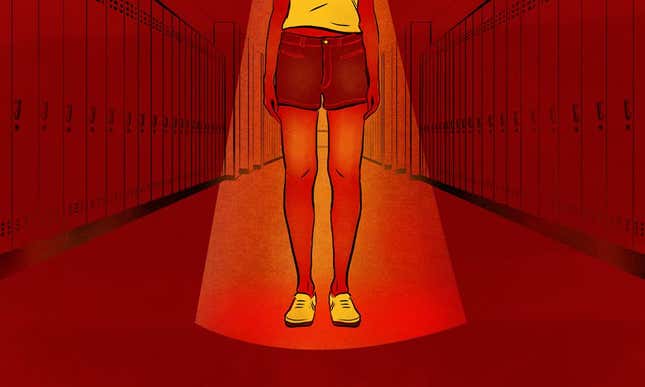What High School Dress Codes Teach Our Daughters
Latest

“Stand up straight,” I tell my daughter, for the tenth time in an hour. I notice when she rolls her eyes. By the time she’s staring straight ahead again, I have seen myself reflected entirely in her behavior at her exact age of 14. I’ve heard the echoes of my mother instructing me to stop slouching, to stand up straight. And I realize that my daughter is slouching for the same reason I did at her age. She is unsure of how to negotiate her newly developing body—mostly her breasts. What I mistook as a lazy stance was really a slope of insecurity and a desire to hide a feature of womanhood. This moment is part of the learning curve.
In Appleton, Wisconsin, in early May, a teenager named Maria Chavez attended school wearing a crop top and high-waisted pants. A sliver of midriff could be seen, and it was seen. She was called out by her teacher, and, in front of her peers, she was told that it looked like she was just wearing a bra.
Maria was escorted to the nurse’s office, where the nurse picked up the school handbook and read this passage aloud:
Student attire must be respectful of others and appropriate for the educational environment at West High School. Clothing that causes a distraction or disruption in the school . . . is deemed inappropriate for student dress.
Students may not wear scanty and/or revealing clothing. Examples may include but are not limited to: short skirts (need to be mid thigh) or revealing shorts, tube tops, halters, backless tops, spaghetti straps less than one inch, exposed midriffs or undergarments.
Maria was told that she clearly didn’t understand the dress policy. Humiliated, she sought an appointment with her school counselor, who urged her to brush it off. Still, Maria’s self-confidence was dealt a blow of shame. She confided in her mother, Serena, that evening.
When I take my son and daughter shopping in preparation for a family event or for a change of season, it’s easy to observe the difference of approach between them when they’re selecting clothes. My son haphazardly grabs button-down polos, a nice pair of khaki pants. He wonders aloud about a pink-and-white checked option and asks for my advice regarding a tie. Afterwards, he decides to try on some shorts and shirts. He grabs “muscle shirts,” tank tops by the handful, because they are on sale and he loves them. He pulls shorts off the rack and hits the fitting room. I end up giving him my keys and telling him to come back for us when I call; he’s usually finished trying on all of his clothes before his sister even reaches the fitting room.
My daughter, on the other hand, measures strap widths on the multitudes of spring and summer dresses hanging off the junior racks. Straps are either too thin, or there is too much shoulder or back revealed. She knows she won’t be considered appropriate for school. She can opt for a shrug or shawl, but we live in Arizona. It’s usually in the 90s or low 100s before school lets out for summer. She doesn’t want the hassle. Instead, she chooses a dress with cap sleeves even though it is nowhere near her first choice. When my daughter is looking at shorts, I see her stand at attention, arms pressed to her sides. She digs her middle fingers into her thighs to mark the “acceptable shorts length” for girls at her school. Pair after pair of shorts fall far below that length. She gives up and selects cropped pants even though, once again, the pants aren’t her first choice.
Maria’s mother Serena listened to her daughter recall the dress code incident, and she was deeply disturbed by the fact that her daughter came home feeling so much shame. She knew that her daughter was considered attractive by today’s standards; she finds her daughter as intelligent as she does beautiful. They discussed the school dress code. Maria noted that many boys at her school wear muscle shirts and are never called up on violations, even though their chests, and armpits and midriffs are visible.
Mother and daughter discussed the sexualizing of female bodies. They did some research online, and found that, all over the United States, more and more students, mostly female, are speaking out against the gender biases that exist in dress codes. Maria discussed the creepiness she experienced feeling knowing male teachers were able to look her over under the possible guise that they were checking her outfits for school-appropriateness. She worried: it was becoming more hot and humid every day and her school didn’t have air conditioning. Would she have to deal with heat rashes again this year? How could she wear shorts without feeling as though she is being judged?
By conversation’s end, Maria decided to post flyers at school in protest of the dress code. She was excited about her decision to act and felt proud to be participating in the democratic tradition. Three weeks after receiving her dress code violation, she was ready. She asked to be excused to the bathroom during a study hall and proceeded to tape approximately 25 flyers to the school walls. The flyers read, “Don’t prohibit girls from wearing shorts in warm weather; teach boys and male teachers not to over-sexualize female body parts.”
-

-

-

-

-

-

-

-

-

-

-

-

-

-

-

-

-

-

-

-

-

-

-

-

-

-

-

-

-

-

-

-

-

-

-

-

-

-

-

-








































